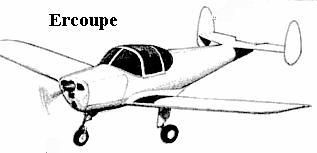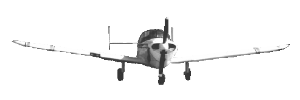 My little green and white Ercoupe (N3948H) was a joy to fly.Its bubble canopy and low wing afforded great visibility,allowing easy scanning for other traffic and enjoyment the view.
My little green and white Ercoupe (N3948H) was a joy to fly.Its bubble canopy and low wing afforded great visibility,allowing easy scanning for other traffic and enjoyment the view.
Of course, some folks thought the airplane was a bit unusual. Itdidn’t have rudder pedals, only a wheel for controlling flight.Its combined aileron and rudder system was unique. It also hada limiting collar on the elevator control travel of the wheel topreclude excessive nose up, potentially leading to stalls. Theonly foot controls were the wheel brakes. You drove the planethrough the air or on the ground like an automobile. Verydifferent.
That Ercoupe, a small under-powered two-seater, was hardly ahigh-performance machine. Its little 75 horsepower Continental engine,fitted with a longer-than-standard fixed-pitch cruisepropeller made it mighty sluggish on climb-out. I recall strugglingone day for two hours to get it above 8,500 feet!That’s all she’d do.
She wasn’t exactly a speed demon, either. Top speed wasat best 120 knots.
But, she was an economical bird to fly. She sipped barely fivegallons of gasoline per hour, except during climb-out. Thenshe’d slurp down petrol at a ravenous seven to eight gallons per hour.Of course, that wasn’t usually much of a problem, because we never triedto climb very high.
 The plane actually belonged to a friend, also stationed atBunker Hill Air Force Base, Indiana. I got to use it almost asmuch as he did, though, in exchange for helping him buyinsurance and getting the bird onto the base. It nested snuglyin the big heated hangar where Aero Club birds were kept. Thatwas terrific, especially in the cold and snow of thosemid-western winters.
The plane actually belonged to a friend, also stationed atBunker Hill Air Force Base, Indiana. I got to use it almost asmuch as he did, though, in exchange for helping him buyinsurance and getting the bird onto the base. It nested snuglyin the big heated hangar where Aero Club birds were kept. Thatwas terrific, especially in the cold and snow of thosemid-western winters.
My friend and I took turns flying it. Fortunately, our dutyschedules meshed almost perfectly. He was on alert when I wasnot, and vice-versa. So it was almost like having my ownairplane, without the headaches. Such a deal.
We each contributed two dollars per hour of flight to a kittydedicated to annual inspection and repair costs. And with80-octane avgas at twenty-five cents per gallon, she was very economical tooperate. Hmmm…did I mention that this was back in the 1960s?
Flying her from that Air Force base presented some interestingexperiences. That tiny little airplane was dwarfed by theB-58 bombers and KC-135 tankers. We had to be really careful notto get in their way or caught in the jet wash of their hugeengines. We must have looked like a gnat to the commanders of thosebig airplanes!
Crosswind technique
Since the plane had no separate rudder control, taking off andlanding under crosswind conditions could be challenging, or atleast quite different from conventional airplanes. Having a200-foot wide runway made handling crosswinds a lot easier, becausewe could take off and land on a diagonal, while remaining onthe pavement. In fact, if the crosswind was strong, the takeoff andlanding roll wasn’t much longer than the runway was wide.On narrow runways, crosswinds were a bit more interesting.
On takeoff we’d typically roar down the runway until speedexceeded that needed for liftoff, and then quickly yank her airborneto avoid scrubbing the tires in crosswinds. For landing we’destablish a crab to compensate for the winds and firmly plop herdown, while letting go of the control wheel. She’d straightenout, like an arrow, and track down the runway pretty much on herown.
Speed control
One cold but sunny winter day, I got to practice someground-controlled radar approaches. Traffic was especially light at theairfield and the GCA controllerswere willing to practice their skills on me. They guided me to along straight-in approach to the runway, taking me eight milesor more off to the northeast of the base and then directing meback for landing. My airspeeds were around 90 knots, making me abarely moving target on their radar scopes.After two or three practice approaches, they suddenly asked meto expedite my landing. There was a B-58 "Hustler"coming in behind me atits usual 220 knots approach speed. I was becoming a problem.
"Okay, GCA. I’ll expedite," I responded. Soon I was just a milefrom the end of the runway, screaming along at 120 knots. Thatwas as fast as I could go, believe me. Still it wasn’t enough, so GCA toldme to turn left and clear the traffic pattern. Within secondsthat big jet roared past me for landing. I decided that Ercoupewasn’t meant to mix it up with the big boys.
Fuel system
 On another flight, a fuel system problem highlighted one moreunusual feature of the little Ercoupe. On a short hop to FortWayne, just 60 miles northeast of Bunker Hill, I noticed thatthe float gauge indicator of the reserve tank looked low. Sureenough, I was burning fuel out of that little tank forward ofthe instrument panel, and not from the wing tanks. The float wasdropping down, indicating that the reserve tank was no longerfull. Normally, fuel is pumped from the wing tanks into the reserve tank,and from there it gravity-fed to the engine. So normally, the reserve tank staysfull unless the wing tanks have run dry.
On another flight, a fuel system problem highlighted one moreunusual feature of the little Ercoupe. On a short hop to FortWayne, just 60 miles northeast of Bunker Hill, I noticed thatthe float gauge indicator of the reserve tank looked low. Sureenough, I was burning fuel out of that little tank forward ofthe instrument panel, and not from the wing tanks. The float wasdropping down, indicating that the reserve tank was no longerfull. Normally, fuel is pumped from the wing tanks into the reserve tank,and from there it gravity-fed to the engine. So normally, the reserve tank staysfull unless the wing tanks have run dry.I wondered if it was really a dropping of the reserve tank fuelor, perhaps, a bad float. The fuel gauge was pretty basic:a small metal rod, protruding upthrough the reserve tank gas cap provided a simple and directindication of how much fuel the tank held. A full tank pushedthe float to its topmost position and plenty of rod was visible.But now the rod was shorter, by half, indicating a lowfuel condition. The fuel gravity fed into the engine carburetor,so long as the reserve tank held fuel. I feared that soon itwouldn’t.
Upon landing at Fort Wayne, I taxied over to the repair shop ina big wooden hangar. The mechanic confirmed my suspicions thatmy fuel pump was not filling the reserve tank. A replacementpump solved the problem. I was on my way, seventy-five dollarspoorer, within a hour. Luckily, we had enough money in themaintenance kitty to cover that expense.
Low maintenance
In the two or three years that I enjoyed the luxury of access tothat little airplane, we repaired very little. A new battery anda replacement windshield were the only significant fixes I recall.Most of theroutine servicing and minor repairs we did ourselves. Ercoupesare very simple airplanes.I sure miss flying that delightful little airplane. But what I really missmost of all is the low cost of flying which no longer exists. At today’sprices, I can’t even afford to fly anymore. Too bad.


































